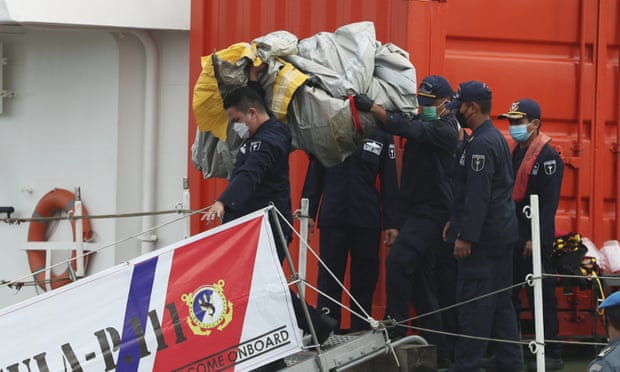Sriwijaya Air flight carrying 62 people crashed after taking off from Jakarta on Saturday
Indonesian authorities have located the black boxes of the Sriwijaya Air jet that crashed into the sea soon after taking off from the capital Jakarta, as human body parts and suspected pieces of the plane were retrieved.
The Boeing 737-500 with 62 passengers and crew was heading to Pontianak in West Kalimantan on Saturday when it disappeared from radar screens four minutes after takeoff.
It is the first major air crash in Indonesia since 189 passengers and crew were killed in 2018 when a Lion Air Boeing 737 Max also plunged into the Java Sea soon after takeoff from Soekarno-Hatta international airport.
Even before the latest crash, more people had died in air crashes in Indonesia than in any other country over the past decade, according to Aviation Safety Network’s database.
Indonesia’s national transport safety committee chief, Soerjanto Tjahjono, said the locations of flight SJ182’s two black boxes had been identified.
“Hopefully we can retrieve them soon,” said the military chief, Hadi Tjahjanto, without giving an estimated timeframe.
Rescuers brought pieces of wreckage to Jakarta port. Authorities said they came from a depth of 23 metres (75ft) near a group of islands off the Jakarta coast. One twisted piece of metal was painted in Sriwijaya Air’s blue and red colours. Indonesian authorities said they had also retrieved body parts and clothing.
Police asked families to provide information such as dental records and DNA samples to help identify bodies.
The plane had 12 crew and 50 passengers onboard, including seven children and three babies, all of them Indonesian.
President Joko Widodo expressed “deep condolences” over the disaster and urged the public to pray the missing people could be found.
The tracking service Flightradar24 said the aircraft took off at 2.36pm local time (0736 GMT) and climbed to reach 10,900ft within four minutes. It then began a steep descent and stopped transmitting data 21 seconds later.
There were no immediate clues on what caused the jet’s sudden descent. Most air accidents are caused by a range of factors that can take months to establish, safety experts say.
A transport ministry spokeswoman said air traffic control had asked the pilot why the plane was heading north-west instead of on its expected flight path seconds before it disappeared.
The pilots had decades of experience between them. The captain was reported to be a former air force pilot and his co-pilot had been at Sriwijaya Air since 2013, according to his LinkedIn profile.
The plane was nearly 27 years old, much older than Boeing’s 737 Max model, which has been plagued with problems. Older 737 models are widely flown and do not have the stall-prevention system implicated in the Max safety crisis.
“We are in contact with our airline customer and stand ready to support them during this difficult time,” Boeing said in a statement. “Our thoughts are with the crew, passengers, and their families.”
Distraught relatives waited in Pontianak, which is about 460 miles (740km) from Jakarta, for news of their loved ones. A crisis centre was set up for families at Jakarta’s main airport.
“We feel powerless, we can only wait and hope to get any information soon,” Irfansyah Riyanto, who had five relatives on the flight, told reporters.
Founded in 2003, Jakarta-based Sriwijaya Air flies largely within Indonesia’s sprawling archipelago. The budget airline has had a solid safety record, with no onboard casualties in four incidents recorded on the Aviation Safety Network database.
The EU banned all Indonesian airlines in 2007 after a series of crashes and reports of deteriorating oversight and maintenance since deregulation in the late 1990s. The restrictions were lifted in 2018.
Source: The Guardian
